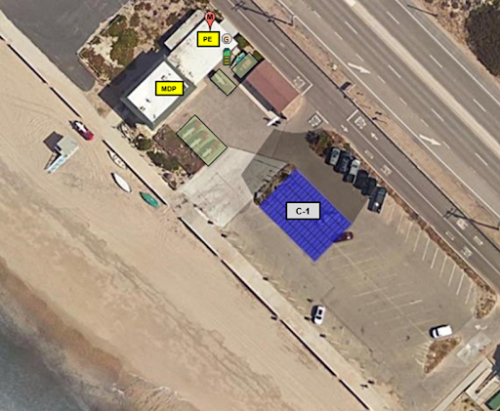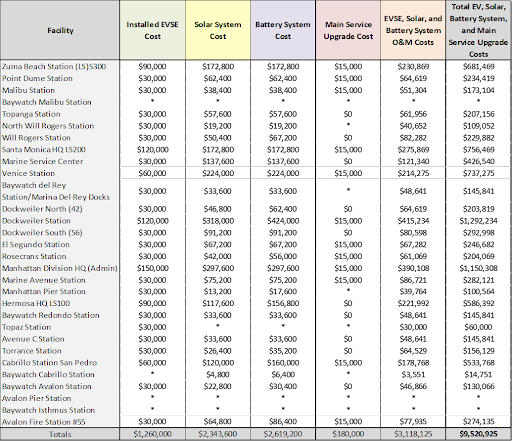
Feasibility Study for EVSE & Solar Microgrids kicks off for thirty LA County Lifeguard Station sites
In a blog post written by the Clean Coalition, we explain a recent study on EVSE & Solar Microgrids at 30 LA County Lifeguard District sites.
In partnership with Los Angeles County, the Clean Coalition has produced a study to determine technical viability and the preliminary costs for installing EVSE & Solar Microgrids at 30 Lifeguard District sites
As a part of LA County’s proactive approach towards transitioning their County vehicles from gas to electric, the Clean Coalition has produced a study, in partnership, that analyzes the technical viability and associated costs of installing Electric Vehicle Service Equipment (EVSE) and Solar Microgrids at 30 LA County Lifeguard District sites. With these results, the County will assess next steps, which may include a more in-depth study of the 25-year cumulative savings for all technically viable sites through either a cash purchase transaction or Price Purchase Agreement (PPA).
Summary of technical viability
The Clean Coalition analyzed 30 Lifeguard District sites for the technical viability of installing EVSE and Solar Microgrids. This includes EV charging stations, rooftop solar or solar parking canopies, battery energy storage, and microgrid functionality. The following is a summary of the technical viability, discovered through site visits performed by the Clean Coalition:
- 26 sites were deemed viable for EVSE, solar, and battery energy storage with microgrid capabilities
- Four sites were not deemed viable for the following reasons:
- Lack of available parking for County vehicles to charge. However, the four sites that were not deemed viable for EVSE could have their associated vehicles charged at other nearby Lifeguard District sites or public charging stations.
- Lack of solar siting opportunities on rooftops or parking areas.
- Lack of locations for battery energy storage that were in proximity to a site’s electrical infrastructure.
- The development of EVSE and Solar Microgrids at some of the Lifeguard District sites is contingent upon the cooperation with other departments and cities.
- Four sites were not deemed viable for the following reasons:
Summary of sizing and costs
The sizing and costs are directly correlated in understanding the technical viability of EVSE and Solar Microgrids. Calculating the energy consumption of future Lifeguard District vehicles depends on understanding the road and sand miles driven by these vehicles. Subsequently, sizing the solar and storage to account for this increased energy consumption at each site will help to determine the cost for installing these systems. The summary of sizing and costs for installing EVSE and Solar Microgrids at 26 Lifeguard District sites includes:
- EVSE sizing and costs:
- 84 EV charging ports for 74 vehicles.
- $1.3 million of capital expenditure (capex):
- $15,000 per port based on a 20 port installation with Load Management Controllers.
- $1.7 million of Operations and Maintenance (O&M) over 25 years:
-
- Includes EVSE replacement at Year 15 and $300 per port per year for the Load Management Controller.
- Sites with 1-2 vehicles include only EVSE replacement costs and do not include load management controller costs.
-
- Solar system sizing and costs:
- 655 kW of solar on either rooftops or parking canopies:
- $2.3 million of capex ($3/W for rooftop solar & $4/W for solar canopies)
- $700,000 in O&M over 25-Years, which includes inverter replacement at Year 15 and annual panel cleanings.
- 655 kW of solar on either rooftops or parking canopies:
- Battery energy storage with microgrid capabilities sizing and costs:
- 655 kW / 1,310 kWh of battery energy storage.
- $2.6 million of capex for battery energy storage with microgrid capabilities ($2,000/kWh):
- Microgrid capabilities include a microgrid controller and load management solutions ($500/kWh)
- $753,000 in O&M over 25-Years, which includes battery replacement at Year 15.
- Main service panel upgrade sizing and cost:
- 11 sites will need a main service panel upgrade in order to handle the high demand of an EV charging station or to be able to backfeed solar onto the grid:
- 8 main service panels were not available and assessed due to constraints around their visibility.
- $180,000 of capex for main service panel upgrades ($15,000 per main service panel upgrade, including $8,000 per panel & $7,000 for labor).
- 11 sites will need a main service panel upgrade in order to handle the high demand of an EV charging station or to be able to backfeed solar onto the grid:

Zuma Beach Station case study
In order to determine the economic viability of adding EVSE and Solar Microgrids at LA County Lifeguard District sites, the Clean Coalition performed its Solar Microgrid Methodology on the Zuma Beach Station site as a case study for proving the viability at other sites. This includes a EVSE & solar-only 25-Year cash purchase economic analysis and a EVSE & Solar Microgrid 25-Year cash purchase economic analysis.
The following section gives insight on some of the economic terms used in the analysis:
Key economic terms
- Capital Expenditure (capex):
- The total amount of money needed to design and build the EVSE, solar, storage, and/or the main service upgrades.
- Operational Expenditure (opex):
- The operating & maintenance expenses for the EVSE, solar, and/or storage systems over a 25-year period.
- In terms of solar & storage, the opex includes annual panel cleanings to remove soiling and equipment replacement, which happens on average at Year 15.
- Powerflex EVSE equipment replacement has not been determined.
- 30% Direct Pay Investment Tax Credit (ITC):
- The Inflation Reduction Act (IRA) of 2022 contains a “direct pay” provision that enables certain tax-exempt customers, including state and local governments, to receive a direct cash payment in lieu of an investment tax credit (ITC). Entities that qualify for direct pay are eligible to receive a 30% direct payment, assuming they meet the IRA established prevailing wage and apprenticeship requirements in order to qualify for the full 30% “increased rate”, rather than a 6% “base rate”.
- The 30% Direct Pay ITC applies only to solar, storage, and main service upgrades.
- Net total project cost:
- The sum of the capex, opex, and the 30% Direct Pay ITC.
- Cumulative utility bill savings:
- The amount of utility bill savings occurring over a 25-Year period.
- This includes energy savings from using solar energy in real-time, instead of energy from the grid, or from Net Energy Metering (NEM) credits.
- It also includes demand savings from demand reduction, which is reducing the demand charges associated with a site’s max demand.
- A 5% annual utility cost escalator was also included, assuming that utility rates for electricity will likely go up 5% a year for the next 25-Years.
- Net cumulative savings:
- The sum of the net total project cost and the cumulative utility bill savings over a 25-Year period.
- Value of Resilience (VOR):
- Clean Coalition’s VOR Methodology states that a typical Solar Microgrid that meets Net Zero Energy is generally worth a 25% adder to the annual electricity bill.
Zuma Beach Station EVSE & solar-only 25-Year cash purchase key economic details:
- Capex: ($277,800)
- 25-Year opex: ($181,189)
- 30% Direct Pay ITC: $56,340
- 25-Year net total project cost: ($402,649)
- 25-Year cumulative utility bill savings: $440,327
- 25-Year net cumulative savings: $37,678
Zuma Beach Station EVSE & solar-only cash purchase 25-Year cash flow
Zuma Beach Station EVSE & Solar Microgrid 25-Year cash purchase key economic details:
- Capex: ($450,600)
- 25-Year opex: ($230,869)
- 30% Direct Pay ITC: $108,180
- 25-Year net total project cost: ($573,289)
- 25-Year cumulative utility bill savings: $550,703
- 25-Year net cumulative savings: ($22,586)
- 25-Year Value of Resilience: $217,266






